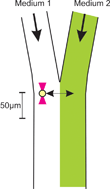A microfluidic system in combination with optical tweezers for analyzing rapid and reversible cytological alterations in single cells upon environmental changes†
Abstract
We report on the development of an experimental platform where epi-fluorescence


 Please wait while we load your content...
Please wait while we load your content...